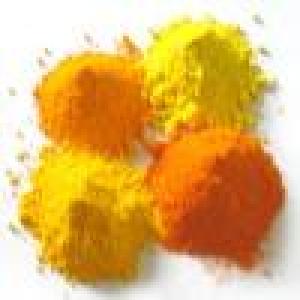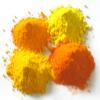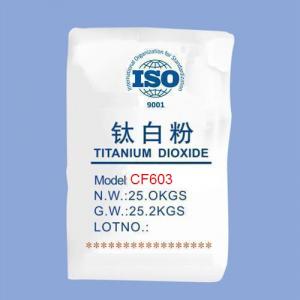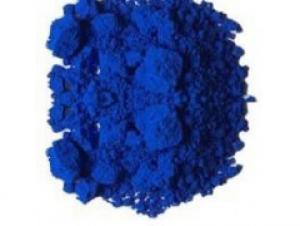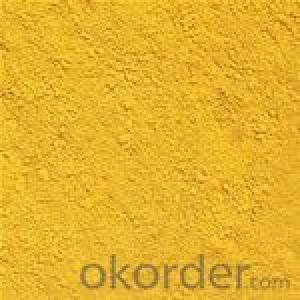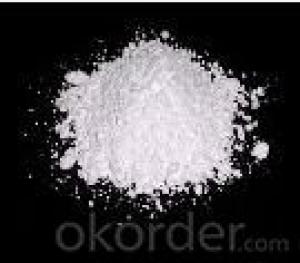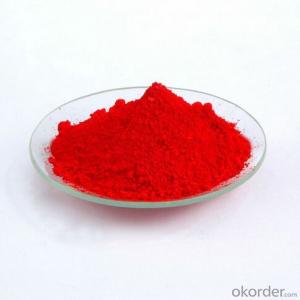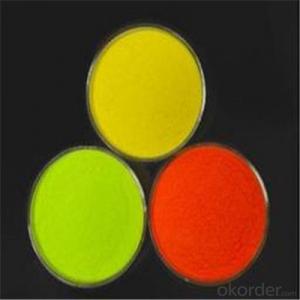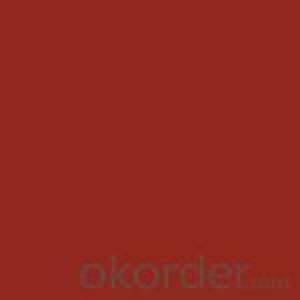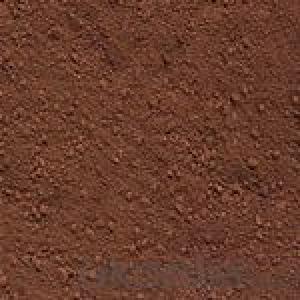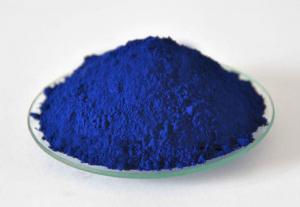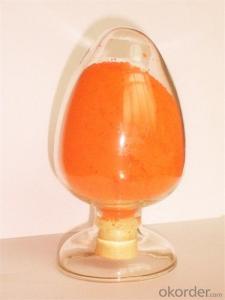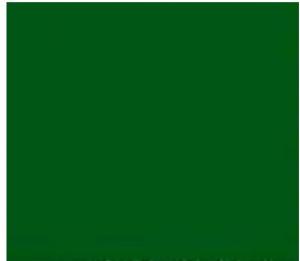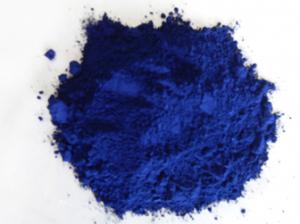Middle chrome yellow 103N
- Loading Port:
- China Main Port
- Payment Terms:
- TT OR LC
- Min Order Qty:
- -
- Supply Capability:
- -
OKorder Service Pledge
OKorder Financial Service
You Might Also Like
Quick Details
Product form: Yellow powder
Category: Yellow pigment PbCrO4
Color reference number : Pigment yellow 34 (77600)
CAS No. : 7758-97-6
Uses : Ink, coating, plastic
Specifications
Color value and tinting strength
| Minimum | Maximum |
Binding material alkyd resin for use in test | ||
Color | Approximate | A little |
△E*ab |
| 1.0 |
Relative tinting strength [%] | 95 | 105 |
Technical data
| Minimum | Maximum |
Water soluble matter [%] |
| 1.0 |
Residue on sieve (0.045mm) [%] |
| 0.3 |
pH value | 6.0 | 9.0 |
Oil absorption [g/100g] |
| 22 |
105℃ volatile matter |
| 1.0 |
Heat resistance (maximum temperature after heating for 5 minutes) [℃] | ~ 240 | |
Light resistance[grade] | ~ 7-8 | |
Weather resistance [grade] | ~ 4 | |
Packing
25kg/bag
Storage and transportation
Keep in dry place.
Opened product
should be tightly sealed to protect from damp and contamination.
- Q: can the pigment know as Chinese purple form a matter wave in certain circumstances?
- Scientists explore atomic mysteries of ancient pigment LOS ALAMOS, N.M., Nov. 18, 2004 -- University of California scientists from the National High Magnetic Field Laboratory, Pulsed Field Facility at Los Alamos National Laboratory, working with colleagues from Tokyo Metropolitan University, the University of Buenos Aires in Argentina, the National Institute of Chemical Physics and Biophysics in Estonia, the National High Magnetic Field Laboratory in Tallahassee, Florida and the University of Tokyo, have discovered an ideal candidate for Bose-Einstein condensation in the ancient Chinese pigment, Han Purple. In research featured recently on the cover of Physical Review Letters, the team describes how the application of a strong magnetic field to Han Purple (BaCuSi2O6) creates a gas of bosonic spin triplet excitations. The field acts as a chemical potential causing the weakly interacting bosonic gas to undergo Bose-Einstein condensation (BEC) when the temperature is reduced to minus 453 degrees Fahrenheit, six orders of magnitude higher than the temperature normally required for BEC in atomic gases.
- Q: why light and pigments are different?
- A pigment is a material that changes the color of reflected or transmitted light as the result of wavelength-selective absorption. This physical process differs from fluorescence, phosphorescence, and other forms of luminescence, in which a material emits light. Many materials selectively absorb certain wavelengths of light. Materials that humans have chosen and developed for use as pigments usually have special properties that make them ideal for coloring other materials. A pigment must have a high tinting strength relative to the materials it colors. It must be stable in solid form at ambient temperatures. For industrial applications, as well as in the arts, permanence and stability are desirable properties. Pigments that are not permanent are called fugitive. Fugitive pigments fade over time, or with exposure to light, while some eventually blacken. Pigments are used for coloring paint, ink, plastic, fabric, cosmetics, food and other materials. Most pigments used in manufacturing and the visual arts are dry colourants, usually ground into a fine powder. This powder is added to a vehicle (or binder), a relatively neutral or colorless material that suspends the pigment and gives the paint its adhesion.
- Q: I know the difference between the two, but which do you prefer? Which has a better color payoff? And, which do you own more of?
- pigments! they're only about 5 dollars more than an eyeshadow and there's so much in that little tub that it can last you forever! and the color payoff is a lot better. you can also use pigments for a lot more things, like mix it with clear lip gloss to make a really pretty lip shade, mix it with hair gel to put temporary color in your hair, or of course as eye shadow. and you could use it wet or dry depending on how intense you want your color i own more pigments than eyeshadows :]
- Q: Does albinism cause lack of ALL pigment, or just black pigment? Does this very on the species?
- Mammals and birds only have melanocytes (these produce varying amounts of brown or black pigment), so that's the only pigment that needs to be affected for them to display albinism. But other types of animals have multiple types of chromatophores. An albino snake, for example, would also need to have the cells that produce reds, yellows, and blues deactivated to appear white/colorless. For these animals to appear as albinos, all pigments would have to be affected.
- Q: what is pigment?
- a pigment has some kinds like biological pigment and arsenic pigment. i dont know much about the arsenic pigment. i would just tell something about the biological pigment. in biology, pigment is any material resulting in color of plants or animals cells. many biological structures like eyes,fur,hair and skin contains pigments like melanin in specialized cells called chromatophores.
- Q: I got this question from my A2 Biology but I can't find the answer. Does anybody know?
- Color. Chlorophyll a is light green. The accessory pigments, chlorophyll b is olive green, the xanthophylls are yellow/brown, and the carotenes are red.
- Q: How can you extract pure pigments from a sample of leaves in a form that you could test the absorbency of the various pigments??I don't know how to extract enough pigment in order to fill a cuvette and measure the absorbance, please help!! :D
- Separation of plant pigments using chromatography. Paper chromatography is a useful technique in the separation and identification of different plant pigments. In this technique, the mixture containing the pigments to be separated is first applied as a spot or a line to the paper about 1.5 cm from the bottom edge of the paper. The paper is then placed in a container with the tip of the paper touching the solvent. Solvent is absorbed by the chromatographic paper and moved up the paper by capillary action. As the solvent crosses the area containing plant pigment extract, the pigments dissolve in and move with the solvent. The solvent carries the dissolved pigments as it moves up the paper. The pigments are carried along at different rates because they are not equally soluble. Therefore, the less soluble pigments will move slower up the paper than the more soluble pigments. This is known as developing a chromatogram.
- Q: I was intrested in buying some pigments on ebay but they dont say the name they just say these nubers #68 #69 #93 do u no what pigment name they are u could serch it that might help thank you
- MAC pigments actually have the name listed on the bottom. If the pigments on OKorder do not, you are more than likely looking at fakes.
Send your message to us
Middle chrome yellow 103N
- Loading Port:
- China Main Port
- Payment Terms:
- TT OR LC
- Min Order Qty:
- -
- Supply Capability:
- -
OKorder Service Pledge
OKorder Financial Service
Similar products
Hot products
Hot Searches
Related keywords
